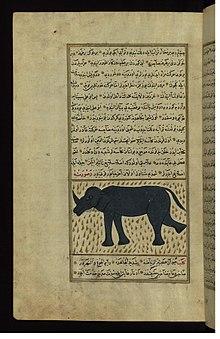കർക്കടൻ
ഈ ലേഖനത്തിന്റെ യാന്ത്രികവിവർത്തനത്തിന്റെ പ്രശ്നങ്ങൾ ശരിയാക്കാൻ തിരുത്തലുകൾ വേണ്ടിവന്നേയ്ക്കും. (2023 സെപ്റ്റംബർ) |
ഇന്ത്യയിലെയും പേർഷ്യയിലെയും പുൽമേടുകളിൽ ജീവിച്ചിരുന്നതായി പറയപ്പെടുന്ന ഒരു പുരാണ ജീവിയാണ് കർക്കടൻ (അറബിക് كركدن karkadann അല്ലെങ്കിൽ Kargadan എന്നതിൽ നിന്നുള്ള karkaddan, പേർഷ്യൻ: كرگدن).
 This folio from Walters manuscript W.659 depicts a Karkadann. | |
| മിത്തോളജി | Medieval Persian tradition |
|---|---|
| വിഭാഗം | Legendary creature |
| പ്രദേശം | India, Persia |
| സമാന ജീവികൾ | Qilin, Re'em, Indrik, Shadhavar, Camahueto, Unicorn |
കർഗദൻ എന്ന വാക്കിന് പേർഷ്യൻ, അറബിക് ഭാഷകളിൽ കാണ്ടാമൃഗം എന്നും അർത്ഥമുണ്ട്.
ഉത്തരേന്ത്യൻ കലകളിലും കർക്കടന്റെ ചിത്രീകരണങ്ങൾ കാണാം.[1]യൂണികോണിനെപ്പോലെ, കന്യകമാരെ കീഴടക്കാനും മറ്റ് മൃഗങ്ങളോട് ക്രൂരമായി പെരുമാറാനും കഴിയും. യഥാർത്ഥത്തിൽ ഇന്ത്യൻ കാണ്ടാമൃഗത്തെ (വാക്കിന്റെ അർത്ഥങ്ങളിലൊന്ന്) അടിസ്ഥാനമാക്കിയുള്ളതും 10/11 നൂറ്റാണ്ടിൽ ആദ്യമായി വിവരിച്ചതും,[1] പിൽക്കാല എഴുത്തുകാരുടെ കൃതികളിൽ ഇത് "നിഴൽ നിറഞ്ഞ കാണ്ടാമൃഗത്തിന്റെ പൂർവ്വികനുള്ള" [2]വിചിത്രമായ ഒരു പുരാണ മൃഗമായി പരിണമിച്ചു.
പേര്
തിരുത്തുകഒരു കൊമ്പുള്ള കഴുത [കർ കിറ്റ് ഡാൻ] എന്നർത്ഥം വരുന്ന കുർദിഷ് പേരിന്റെ ഒരു വ്യതിയാനമാണ് കർക്കടൻ എന്ന പേര്. പേർഷ്യൻ കർഗദാൻ, അല്ലെങ്കിൽ സംസ്കൃത കർത്തജൻ, "മരുഭൂമിയുടെ അധിപൻ" എന്ന് പറയപ്പെടുന്നു.[3] അബിസീനിയയിൽ നിന്നുള്ള അറബികൾ വഴിയാണ് ഈ വാക്ക് സെമിറ്റിക് ഭാഷകളിൽ പ്രവേശിച്ചതെന്ന് ഫ്രിറ്റ്സ് ഹോമ്മൽ സംശയിക്കുന്നു.[4] മറ്റ് അക്ഷരവിന്യാസങ്ങളിലും ഉച്ചാരണങ്ങളിലും കർക്കാഡൻ,[5] കർദൂൻ,[6] കർക്കടൻ, കർക്കെൻഡ് എന്നിവ ഉൾപ്പെടുന്നു.[7][8]
മഹാഭാരതത്തിൽ നിന്നുള്ള പുരാണത്തിലെ ഒരു വിവരണത്തിൽ കർക്കടകത്തിന്റെ ഉത്ഭവം ഉണ്ടാകുമെന്ന് അനുമാനിക്കപ്പെടുന്നു.[9]
പേർഷ്യൻ കർഗദാനിന്റെ പ്രാരംഭ ഭാഗം കാണ്ടാമൃഗത്തിന്റെ സംസ്കൃത പദമായ "ഖർഗ" യോട് സാമ്യമുള്ളതാണ്, വാൾ എന്നും അർത്ഥമുണ്ട്, ഇവിടെ "R" എന്നത് ഒരു റിട്രോഫ്ലെക്സ് ഫ്ലാപ്പ് ശബ്ദത്തെ പ്രതിനിധീകരിക്കുന്നു. കാണ്ടാമൃഗം "വാൾ കൊമ്പൻ" ആണ്.
അവലംബം
തിരുത്തുക- ↑ 1.0 1.1 Suhr, Elmer G. (1964). "An Interpretation of the Unicorn". Folklore. 75 (2): 91–109. doi:10.1080/0015587x.1964.9716952.
- ↑ Lavers, Chris (2010). The Natural History of Unicorns. RandomHouse. pp. 107–109. ISBN 978-0-06-087415-5.
- ↑ Lunds universitet. Historiska museet samt mynt- och medaljkabinettet (1973). Meddelanden från Lunds Universitets historiska museum: Mémoires du Musée historique de l'Université de Lund. C.W.K. Gleerup. p. 193.
- ↑ Hommel, Fritz (1879). Die Namen der Saugethiere bei den Sudsemitischen Volkern. pp. 328–29.
- ↑ Hees, Syrinx von (2002). Enzyklopädie als Spiegel des Weltbildes. Otto Harrassowitz Verlag. pp. 205–208. ISBN 978-3-447-04511-7.
- ↑ Contadini, Anna (2003). "A Bestiary Tale: Text and Image of the Unicorn in the Kitāb naʿt al-hayawān (British Library, or. 2784)" (PDF). Muqarnas. 20: 17–33. doi:10.1163/22118993-90000037. JSTOR 1523325.
- ↑ Lane, Edward William (1841). The thousand and one nights, commonly called, in England, the Arabian nights' entertainments. p. 95 note 29.
- ↑ Manguel, Alberto; Gianni Guadalupi (2000). The dictionary of imaginary places. Houghton Mifflin Harcourt. p. 109. ISBN 978-0-15-600872-3.
- ↑ Ettinghausen, Richard (1955). Late Classical and Medieval Studies in Honor of Albert Mathias Friend Jr. Princeton UP. p. 286.
External links
തിരുത്തുക- Image of Karkadann from MS Munich Cod. Arab. 464, containing Al-Qazwini's ʿAjā'ib al-makhlūqāt wa gharā'ib al-mawjūdāt